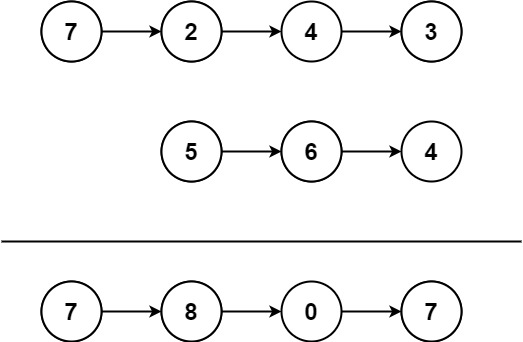这是一种经常考察的思维:大数相加 。一般有以下几种数据结构类型的考察方式:
给定一个由 整数 组成的 非空 数组所表示的非负整数,在该数的基础上加一。
最高位数字存放在数组的首位, 数组中每个元素只存储单个 数字。
你可以假设除了整数 0 之外,这个整数不会以零开头。
1 2 3 输入:digits = [1 ,2 ,3 ] 输出:[1 ,2 ,4 ] 解释:输入数组表示数字 123 。
1 2 3 4 5 6 7 8 9 10 11 12 13 14 15 class Solution {public : vector<int > plusOne (vector<int >& digits) { int n = digits.size (), add = 1 ; for (int i = n - 1 ; i >= 0 && add; i--) { int res = digits[i] + 1 ; digits[i] = res % 10 ; add = res / 10 ; } if (add) { digits.insert (digits.begin (), 1 ); } return digits; } };
给定两个字符串形式的非负整数 num1 和num2 ,计算它们的和并同样以字符串形式返回。
你不能使用任何內建的用于处理大整数的库(比如 BigInteger), 也不能直接将输入的字符串转换为整数形式。
示例 1:
1 2 输入:num1 = "11" , num2 = "123" 输出:"134"
1 2 3 4 5 6 7 8 9 10 11 12 13 14 15 16 17 18 class Solution {public : string addStrings (string num1, string num2) { int i = num1.l ength() - 1 , j = num2.l ength() - 1 , add = 0 ; string ans = "" ; while (i >= 0 || j >= 0 || add) { int x = i >= 0 ? num1[i] - '0' : 0 ; int y = j >= 0 ? num2[j] - '0' : 0 ; int result = x + y + add; ans.push_back ('0' + result % 10 ); add = result / 10 ; i--; j--; } reverse (ans.begin (), ans.end ()); return ans; } };
1 2 3 输入:l1 = [2 ,4 ,3 ], l2 = [5 ,6 ,4 ] 输出:[7 ,0 ,8 ] 解释:342 + 465 = 807.
1 2 输入:l1 = [9 ,9 ,9 ,9 ,9 ,9 ,9 ], l2 = [9 ,9 ,9 ,9 ] 输出:[8 ,9 ,9 ,9 ,0 ,0 ,0 ,1 ]
1️⃣ 迭代 1 2 3 4 5 6 7 8 9 10 11 12 13 14 15 16 17 18 19 20 21 22 23 24 25 26 27 28 29 30 31 32 33 class Solution {public : ListNode* addTwoNumbers (ListNode* l1, ListNode* l2) { ListNode dummy; ListNode* cur = &dummy; int carry = 0 ; while (l1 || l2 || carry) { int res = 0 ; if (l1) { res += l1->val; l1 = l1->next; } if (l2) { res += l2->val; l2 = l2->next; } res += carry; carry = res / 10 ; cur = cur->next = new ListNode (res % 10 ); } return dummy.next; } };
2️⃣ 递归 1 2 3 4 5 6 7 8 9 10 11 12 13 14 15 16 17 18 19 20 21 22 23 24 25 class Solution {public : ListNode* addTwoNumbers (ListNode* l1, ListNode* l2, int carry = 0 ) { if (!l1 && !l2) { return carry ? new ListNode (carry) : nullptr ; } if (!l1) { swap (l1, l2); } int sum = carry + l1->val + (l2 ? l2->val : 0 ); l1->val = sum % 10 ; l1->next = addTwoNumbers (l1->next, (l2 ? l2->next : nullptr ), sum / 10 ); return l1; } };
1 2 输入:l1 = [7 ,2 ,4 ,3 ], l2 = [5 ,6 ,4 ] 输出:[7 ,8 ,0 ,7 ]
✅ 两数相加 II = 两数相加 + 反转链表
1️⃣ 迭代|206. 反转链表(迭代)+ 2. 两数相加(迭代) 1 2 3 4 5 6 7 8 9 10 11 12 13 14 15 16 17 18 19 20 21 22 23 24 25 26 27 28 29 30 31 32 33 34 35 36 class Solution {public : ListNode* reverseList (ListNode* head) { ListNode* pre = nullptr ; ListNode* cur = head; while (cur) { ListNode* nxt = cur->next; cur->next = pre; pre = cur; cur = nxt; } return pre; } ListNode* addTwoNumbers (ListNode* l1, ListNode* l2) { l1 = reverseList (l1); l2 = reverseList (l2); ListNode dummy; ListNode* cur = &dummy; int carry = 0 ; while (l1 || l2 || carry) { int res = carry; if (l1) { res += l1->val; l1 = l1->next; } if (l2) { res += l2->val; l2 = l2->next; } carry = res / 10 ; cur = cur->next = new ListNode (res % 10 ); } return reverseList (dummy.next); } };
2️⃣ 递归|206. 反转链表(递归)+ 2. 两数相加(递归) 1 2 3 4 5 6 7 8 9 10 11 12 13 14 15 16 17 18 19 20 21 22 23 24 25 26 27 28 29 30 31 32 class Solution {public : ListNode* reverseList (ListNode* head) { if (!head || !head->next) { return head; } ListNode* new_head = reverseList (head->next); head->next->next = head; head->next = nullptr ; return new_head; } ListNode* addTwo (ListNode* l1, ListNode* l2, int carry = 0 ) { if (!l1 && !l2) { return carry ? new ListNode (carry) : nullptr ; } if (!l1) { swap (l1, l2); } int sum = carry + l1->val + (l2 ? l2->val : 0 ); l1->val = sum % 10 ; l1->next = addTwo (l1->next, (l2 ? l2->next : nullptr ), sum / 10 ); return l1; } ListNode* addTwoNumbers (ListNode* l1, ListNode* l2) { l1 = reverseList (l1); l2 = reverseList (l2); ListNode* head = addTwo (l1, l2, 0 ); return reverseList (head); } };
给你两个二进制字符串 a 和 b ,以二进制字符串的形式返回它们的和。
示例 1:
1 2 输入:a = "11" , b = "1" 输出:"100"
示例 2:
1 2 输入:a = "1010" , b = "1011" 输出:"10101"
1 2 3 4 5 6 7 8 9 10 11 12 13 14 15 16 17 class Solution {public : string addBinary (string a, string b) { int carry = 0 ; int i = a.length () - 1 , j = b.length () - 1 ; string ans; while (i >= 0 || j >= 0 || carry) { int x = i >= 0 ? a[i--] - '0' : 0 ; int y = j >= 0 ? b[j--] - '0' : 0 ; int s = x + y + carry; carry = s / 2 ; ans.push_back (s % 2 + '0' ); } reverse (ans.begin (), ans.end ()); return ans; } };
给定两个以字符串形式表示的非负整数 num1 和 num2,返回 num1 和 num2 的乘积,它们的乘积也表示为字符串形式。
**注意:**不能使用任何内置的 Big Integer 库或直接将输入转换为整数。
示例 1:
1 2 输入: num1 = "2" , num2 = "3" 输出: "6"
示例 2:
1 2 输入: num1 = "123" , num2 = "456" 输出: "56088"
1️⃣ 竖式相加 思路:建立在「大数相加」的基础上,因为多个数之间需要累加(容易理解)
1 2 3 4 5 6 7 8 9 10 11 12 13 14 15 16 17 18 19 20 21 22 23 24 25 26 27 28 29 30 31 32 33 34 35 36 37 38 39 40 41 42 43 44 45 46 47 48 49 50 51 52 class Solution {public : string addStrings (string num1, string num2) { int i = num1.l ength() - 1 , j = num2.l ength() - 1 , add = 0 ; string ans = "" ; while (i >= 0 || j >= 0 || add) { int x = i >= 0 ? num1[i] - '0' : 0 ; int y = j >= 0 ? num2[j] - '0' : 0 ; int result = x + y + add; add = result / 10 ; ans.push_back ('0' + result % 10 ); i--; j--; } reverse (ans.begin (), ans.end ()); return ans; } string multiply (string num1, string num2) { if (num1 == "0" || num2 == "0" ) return "0" ; int multiply = 0 ; int m = num1.l ength(), n = num2.l ength(); string ans = "0" ; for (int i = m - 1 ; i >= 0 ; i--) { int x = num1[i] - '0' ; string num; int add = 0 ; for (int j = n - 1 ; j >= 0 || add; j--) { if (x == 0 ) { num = "0" ; break ; } if (j < 0 ) { num.push_back ('0' + add); break ; } int y = num2[j] - '0' ; int result = x * y + add; add = result / 10 ; num.push_back ('0' + result % 10 ); } reverse (num.begin (), num.end ()); if (num != "0" ) ans = addStrings (ans, num + string (multiply, '0' )); multiply++; } return ans; } };
2️⃣ 相乘
思路:直接做乘法,长度分别为 m 和 n 的数字相乘,值长度不超过 m + n,vector<int> ansArr(m + n)
1 2 3 4 5 6 7 8 9 10 11 12 13 14 15 16 17 18 19 20 21 22 23 24 25 26 27 28 class Solution {public : string multiply (string num1, string num2) { if (num1 == "0" || num2 == "0" ) { return "0" ; } int m = num1.l ength(), n = num2.l ength(); vector<int > ansArr (m + n) ; for (int i = m - 1 ; i >= 0 ; i--) { int x = num1[i] - '0' ; for (int j = n - 1 ; j >= 0 ; j--) { int y = num2[j] - '0' ; ansArr[i + j + 1 ] += x * y; } } for (int i = m + n - 1 ; i > 0 ; i--) { ansArr[i - 1 ] += ansArr[i] / 10 ; ansArr[i] %= 10 ; } int idx = ansArr[0 ] == 0 ? 1 : 0 ; string ans; while (idx < m + n) { ans.push_back ('0' + ansArr[idx]); idx++; } return ans; } };




